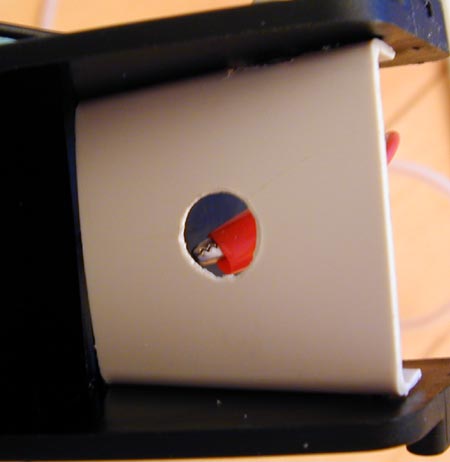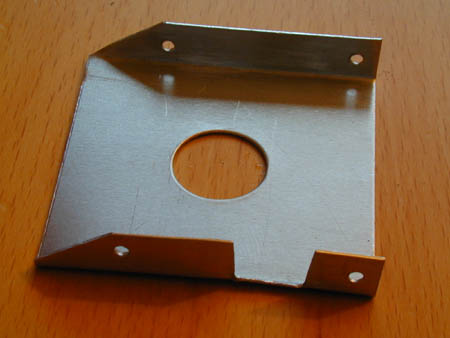Engine cooling
The air flow generated by the fan does not cool the engine very effectively,
because the air can escape into the canopy instead of flowing along the engine.
To improve this poor situation, I put - as recommended by the local shop owner -
a plate between just in front of the engine to guide the air flow. I was told that
there is information about this on the web, but I never encountered it.
So I made one myself.
I saw that new raptors are sold including such a coolplate!

Layout of the extra cooling plate. Sizes in mm. Measure your own raptor sizes,
they may be slightly different from mine.
The plate is mounted about 10 mm from the engine, so that it smoothly attaches
to the old end of the air flow guiding system.
I made a first version of the plate from white plastic, which can be bent if heated up to about 100 to 150
° C. I used special apparatus for that which I had available. That heating apparatus
consists of two wires about 8 to 10 mm apart,
which are being heated by sending electric current through it.
The plastic can be heated by placing it inbetween the wires, and after some 20 to 30 seconds
the plastic is warm enough to bend it. I have flown a couple of times with it,
so the cooling shows good enough to prevent the plastic from bending.


|
The complete plate, ready to mount with M2 bolts.
|
Mounted, seen from the engine side. Make the gap between the old
air flow guide and the plate as small as possible.
|
However, the plastic plate shows not strong enough to stand the vibrations. Cracks
appeared in the plate after some 10 flights. So I had to redo the job,
now with 0.7mm aluminium plate... This works fine,
I have been flying a lot of flights with it now.


|
Cracks after a few flights
|
A new plate, now made of 0.7mm aluminium.
|
Copier sheet
Since end 2002 I am using a plate cut from transparent printer/copier sheet. This
is special high-temperature plastic having the size and thickness of
paper. It can withstand 130°C without bending or deforming, and is
thin enough to go between the OS50 engine head and the helicopter's frame.
This allows extension of the plate at the side of the head, to get additional
cooling. This seems to work very good, the only problem being that the
oil at the inside of the plate is visible so it's not looking very nice.
I encountered the idea on the site of Michael Prewitt, but I can't remember
the name of the guy that send it to him. Michael gives a cutting plan as well,
but I cut it the same form as my other plates except the larger sides and
a few holes for the carb, and attached it the same way with the four holes.
Other solution
at the end of 2002 I found out that my engine run hot not because of
high power demand but because it was running too RICH! Since
I have leaned out the engine drastically I have not felt the need for extra cooling
and I removed the cooling extension.
© W.Pasman, 15/4/01




